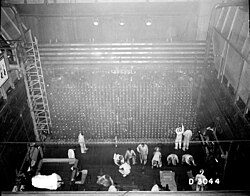Shift-left testing Updated 2025-07-16
Software engineer stereotype Updated 2025-07-16
Sphere Updated 2025-07-16
Test driven development Updated 2025-07-16
This is a good approach. The downside is that while you are developing the implementation and testing interactively you might notice that the requirements are wrong, and then the tests have to change.
One intermediate approach Ciro Santilli likes is to do the implementation and be happy with interactive usage, then create the test, make it pass, then remove the code that would make it pass, and see it fail. This does have a risk that you will forget to test something, but Ciro finds it is a worth it generally. Unless it really is one of those features that you are unable to develop without an automated test, generally more "logical/mathematical" stuff. This is a sort of laziness Driven Development.
B Reactor Updated 2025-07-16
This was the first full scale nuclear reactor in the world, and was brought up slowly to test it out.
Hanford B Reactor tour by Studio McGraw
. Source. 2016.- youtu.be/8rlVHEY7BF0?t=335 good description of the fuel element. It uses uranium metal, not Uranium dioxide
- youtu.be/8rlVHEY7BF0?t=652 N Reactor and F Reactor were identical, and came up 2 months later, but much faster because of what they learned on the B
Breaking Bad Updated 2025-07-16
There is a lot of "who kills who" useless fluff, and everything to do with the wife is boring, but too much gold otherwise.
It is amazing to see how seasons got better and better until the finale. The last season was amazing, Ciro Santilli actually watched all episodes of that one! This is clearly seen on the evolution of metacritic scores.
Gravity and electricity by Hermann Weyl (1918) Updated 2025-07-16
Published on the session reports of the Royal Prussian Academy of Sciences at Berlin 1918 page 464.
Is about Maxwell's equations in curved spacetime, and notably introduces gauge theory.
Viewable for free at: archive.org/details/mobot31753002089727/page/464/mode/2up.
Lu Zhishen saves Lin Chong Updated 2025-07-16
Not Just Bikes Updated 2025-07-16
SQL aggregate function Updated 2025-07-16
Teaching method Updated 2025-07-16
The Nobel Prize is bad Updated 2025-07-16
Typography Updated 2025-07-16
General linear group Updated 2025-07-16
Non-invertible are excluded "because" otherwise it would not form a group (every element must have an inverse). This is therefore the largest possible group under matrix multiplication, other matrix multiplication groups being subgroups of it.
Greenberger-Horne-Zeilinger state Updated 2025-07-16
Maxwell's equations in curved spacetime Updated 2025-07-16
Combination of electromagnetism and general relativity. Unlike combining quantum mechanics and general relativity, this combination was easier.
TODO any experiments of interest at all?
Rho Updated 2025-07-16
ANN model Updated 2025-07-16
Equivalence between Lagrangian and Hamiltonian formalisms Updated 2025-07-16
Unlisted articles are being shown, click here to show only listed articles.

